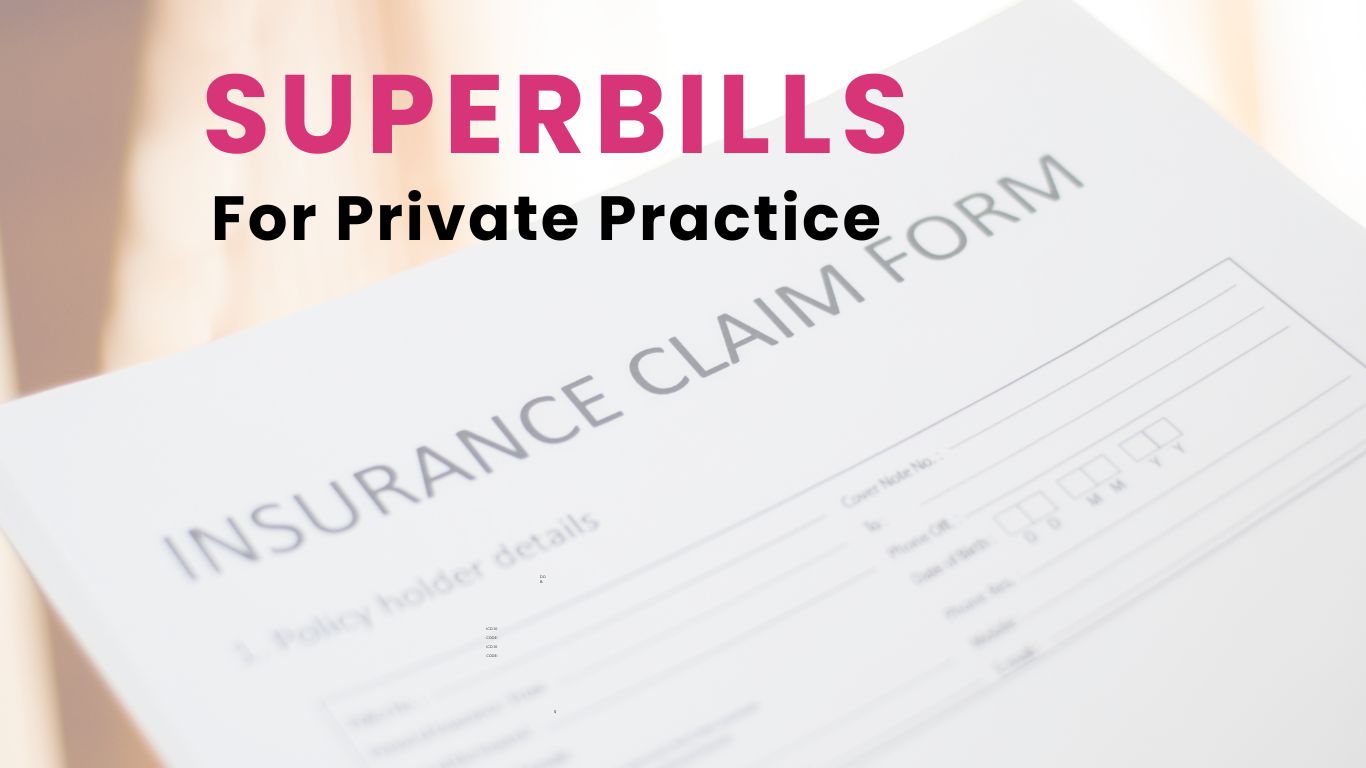Navigating the administrative side of a therapy practice can sometimes feel as challenging as the clinical work itself. If you’re working with private-pay clients or providing out-of-network services, you might feel uncertain when a client asks you for a superbill for the first time. But fear not! In this post, we’ll break down exactly what a superbill is, why it’s essential for your practice and how you can create one that meets all the necessary standards. Plus, I’ll introduce you to a customizable superbill template available here on my site that not only looks professional but also comes with a handy info page linking the codes different types of therapists use. Whether you’re a seasoned professional or new to private practice, this guide will provide you with all the insights you need.
What Is a Superbill?
A superbill is an itemized document that therapists provide to clients upon request detailing the services rendered during a treatment session. Think of it as a comprehensive receipt—but one that’s tailored for the specific needs of therapy practices. It isn’t an invoice for payment; rather, it’s a tool that clients can submit to their insurance companies for potential reimbursement when you work outside of the insurer’s network.
In simple terms, a superbill is the bridge between the service you provide and the reimbursement process for clients who are seeking to recoup their out-of-pocket expenses. By clearly listing each service with corresponding diagnostic and treatment codes (like CPT and ICD-10), a superbill helps ensure that the client’s claim is processed smoothly, saving both you and your client precious time and hassle.
For therapists, understanding and using a superbill is essential—not just for administrative accuracy, but also for fostering trust and transparency with clients. When every detail is clearly documented, clients feel confident in the services they receive and in their ability to navigate the often-complex world of insurance reimbursement.
What's the Difference Between a Superbill and a Good Faith Estimate?
Under the No Surprises Act (effective Jan 1, 2022), all private pay and out-of-network clients must receive a Good Faith Estimate (GFE) of expected costs before starting services. A Superbill is a document private-pay clients may request so they can submit to their insurance for out-of-network reimbursement. It’s not required unless the client requests it. For more details on what the GFE is, read my blog post here.
Why Therapists Need Superbills
Simplifying the Reimbursement Process
For many clients, especially those paying privately or using out-of-network benefits, submitting a superbill to their insurance company can mean the difference between a streamlined reimbursement process and a drawn-out, confusing claim experience. A superbill provides:
- Detailed Treatment Information: It lists every service provided, complete with dates, codes, and amounts. This detail is crucial when clients are asked to prove the legitimacy and necessity of the treatment.
- Accuracy and Compliance: By including all the required fields—from your credentials to the diagnostic codes—superbills help prevent rejected claims due to missing information.
Building Trust and Professionalism
When you take the time to prepare a detailed superbill, you’re not only assisting your clients with insurance reimbursement, you’re also reinforcing your professional standards. It signals to clients that you care about every detail—from their well-being to the financial aspects of their care. In an industry where transparency is key, a well-prepared superbill can be a cornerstone of your practice’s credibility.
Versatility in Practice Models
Whether you’re strictly a private-pay practice or you occasionally offer out-of-network services, superbills are a versatile tool. They work in both scenarios:
- Private-Pay Clients: Clients can submit the superbill to their insurance companies to seek partial reimbursement, easing the financial burden of therapy.
- Out-of-Network Providers: Even if your practice isn’t contracted with insurance companies, a superbill allows clients to leverage their benefits and file claims on their own.
This flexibility makes superbills an indispensable part of your administrative toolkit.
Who Needs Superbills?
Superbills aren’t just for one type of therapist; they’re relevant for almost every professional in the field. Here’s who benefits most:
- Private-Pay Therapists: If you operate on a cash-only basis, superbills enable your clients to seek reimbursement from their insurance, even if you aren’t in-network.
- Out-of-Network Providers: Therapists who aren’t contracted with insurance companies can still assist their clients by providing superbills for claims.
- Various Therapy Disciplines: Whether you’re a speech-language pathologist, occupational therapist, physical therapist, counselor, or psychologist, superbills play a critical role. Each field might have specific codes and billing requirements and a superbill can be tailored to meet these demands.
As an example, the American Speech-Language-Hearing Association (ASHA) offers a free downloadable template for superbills that therapists can access here. This resource is a fantastic starting point for those new to the process or looking to standardize their billing practices. However, for those seeking an even more customizable and comprehensive solution, my superbill template might just be the perfect fit. The Superbill Google Doc template can be found here.
Key Elements of a Complete Superbill
Creating a superbill that meets all insurance requirements involves including several key elements. Let’s break these down:
Clinician Information
- Name and Credentials: Your full name, along with your professional credentials (e.g., CCC-SLP, OTR/L, LCSW, etc.), should be clearly displayed.
- NPI Number: The National Provider Identifier (NPI) is a unique number assigned to healthcare providers in the United States. It’s a critical piece of information for billing.
- Tax ID: Including your tax identification number is essential for any potential audits or verifications.
- Clinician Sign Off: A signature line where you verify the information and confirm that the treatment provided meets the necessary standards. A digital signature is acceptable.
Practice Information
- Business Name and Address: Clearly state the name of your practice along with your office address. This information is vital for both record-keeping and for clients to confirm the legitimacy of the service.
- Contact Information: Phone number and email address so that any follow-up questions regarding the superbill can be directed appropriately.
- Location of Service: In cases where your practice has multiple locations or you provide services at a different site (like a school or community center), specifying the location of treatment is crucial.
Patient Information
- Patient Name and Date of Birth: Accurate identification of the client is necessary to match the superbill with the correct individual.
- Insurance Details (optional): Even if the client is paying out-of-pocket, including a section for insurance details can help if they decide to submit the superbill for reimbursement.
Service Details
- Date of Service: Clearly list when the service was provided.
- Treatment Administered: A detailed description of the service, such as “individual speech therapy session” or “cognitive-behavioral therapy session.”
- Diagnostic Codes: Use ICD-10 codes to describe the diagnosis. This not only justifies the need for the service but also aligns with insurance requirements.
- Treatment Codes: CPT codes (or similar) that identify the type of service provided. These codes help insurers process claims accurately.
- Amount Paid: Clearly indicate the fee for the session and any payments received. If applicable, include information about co-pays or discounts.
- Date of Payment: When the payment was made, ensuring that all financial records are up to date.
Additional Essential Information
- Units of Service: If applicable, note the number of units (e.g., one 50-minute session, group session, etc.) to ensure precise billing.
- Payment Methods: Document whether the payment was made via check, credit card, or another method.
- Notes or Comments: A section for any additional remarks that might be necessary for clarifying details about the session or special circumstances.
Each element serves to validate the session, support reimbursement claims, and provide a clear record for both the therapist and the client. Accuracy here is non-negotiable—errors or omissions can lead to denied claims, frustrating both you and your clients.
How to Create a Superbill
Creating a superbill may sound daunting, but with the right tools and a bit of planning, it becomes a straightforward task. Here are some practical steps to get you started:
Use Google Docs to Create a Professional Superbill
There are several advantages to using Google Docs for this purpose:
- Easy Customization: Google Docs allows you to quickly modify the template to suit your practice’s unique needs.
- Duplicate for Each Client: Once you’ve created a master template, you can easily make a copy for each client, ensuring consistency and saving time.
- Cloud-Based Convenience: Access your documents from anywhere and collaborate with team members if needed.
Alternatively, if you like to use Google Sheets for documentation, a template for a superbill can easily be created using Google Sheets if preferred.
My Customizable Superbill Template
While ASHA provides a free downloadable template, my superbill template offers several additional features that make it even more valuable:
- Customizable Fields: You can easily adjust the template to match the specific billing requirements of your practice.
- Built-In Info Page: The template includes an info page with links to frequently used CPT and ICD-10 codes, making it a breeze for therapists across various disciplines, such as physical therapy, occupational therapy, psychological counseling, or social work, to find the codes you need quickly.
- User-Friendly Design: The layout is intuitive and professional, ensuring that all the required information is clearly presented.
- Google Docs Format: Since it’s in Google Docs, you can share it with your administrative team or use it individually with the click of a button.
Tips for Setting Up Your Superbill in Google Workspace
- Folder Organization: Create a dedicated folder for your client in Google Drive for superbills and billing documents. This ensures all your records are neatly organized and easily accessible.
- Version Control: By reviewing the version history, you can keep track of any changes made to the template. This is especially useful if you update coding information or add new features based on feedback.
- Client-Specific Copies: For every new client, make a copy of the template. This not only helps maintain consistency but also makes it easier to track treatment history and financial details on a per-client basis.
With a few simple steps and a robust template, creating and maintaining superbills can become one of the easiest parts of your administrative routine.
Tips for Using Superbills Effectively
Once you have your superbill template in place, here are some best practices to ensure you get the most out of it:
Educate Your Clients
Many clients may not be familiar with what a superbill is or how to use it:
- Explain the Purpose: Let them know that the superbill is a detailed record that enables them to submit claims for reimbursement to their insurance companies.
- Provide a How-To Guide: Consider including a brief guide explaining the superbill to answer any questions they might have about the process.
Double-Check for Accuracy
Accuracy is critical when it comes to superbills:
- Regular Audits: Periodically review your superbill template to ensure all the fields remain current with the latest billing requirements and codes.
- Proofreading: A quick review after each session can save you from potential headaches later on. A small error can lead to claim rejections, which are best avoided.
Keep It Simple, Yet Detailed
While it’s essential to include all necessary information, avoid overwhelming the client:
- User-Friendly Layout: Ensure the document is clean and easy to read. Use headings, bullet points, and tables where appropriate.
- Optional Sections: If certain fields aren’t applicable for every session, consider making them optional rather than forcing a one-size-fits-all approach.
Avoid Common Mistakes
Some pitfalls to watch out for:
- Missing Information: Ensure that every section—from clinician credentials to payment details—is filled out. Missing data can result in rejected claims.
- Outdated Codes: Regularly update your template to include the latest CPT and ICD-10 codes. This is where the built-in info page in my template can be particularly helpful.
- Inconsistent Formatting: Keeping a consistent format across all superbills not only helps in maintaining a professional appearance but also reduces administrative errors.
Superbill vs. CMS 1500 Form: Key Differences
What is the CMS?
The CMS 1500 is a standardized claim form—originally known as the HCFA 1500—that healthcare providers use to bill insurance companies for reimbursement. It was developed by the Centers for Medicare & Medicaid Services (CMS) and is now widely used not only for Medicare but also for many private insurance claims. Essentially, it gathers all the necessary information about the provider, the patient and the services rendered, ensuring that the claim is complete and can be processed accurately by the insurer.
While both superbills and the CMS 1500 form are used in the billing process, they serve different functions:
Superbill
- Primarily for Private-Pay and Out-of-Network Claims: A superbill is intended to provide clients with the documentation they need to seek reimbursement on their own.
- Simpler Format: It focuses on detailing the service provided, the diagnosis and the payment, without the complexities of insurance billing forms.
- Customizable for Your Practice: You can tailor a superbill to fit the specific services you offer and the needs of your clients.
CMS 1500 Form
- Standardized for Insurance Claims: This form is used when billing directly to insurance companies, with strict formatting and coding requirements.
- Detailed and Structured: It includes more comprehensive information required by insurers, leaving less room for customization.
- Less Flexibility: If you primarily operate as an out-of-network provider, the CMS 1500 form may be more cumbersome than a well-organized superbill.
For therapists in private-pay or out-of-network settings, a superbill is the more straightforward, client-friendly choice.
Simplify Your Superbill Process!
If you’re ready to streamline your billing process and make life easier for both you and your clients, consider checking out my customizable superbill template. Designed specifically for therapists, this template:
- Is in Google Docs Format: Easily accessible and modifiable to fit your practice’s unique requirements.
- Includes a Comprehensive Info Page: With links to essential CPT and ICD-10 codes for various therapy disciplines such as physical therapy, occupational therapy, counseling, and psychology.
- Saves Time: Duplicate for each client with ease, ensuring every superbill is consistent and professional.
- Enhances Accuracy: With all the required fields clearly laid out, you can avoid claim rejections and administrative headaches.
If you are a speech pathologist or audiologist looking for a free superbill template, be sure to check out the ASHA website. And for therapists looking for a streamlined, professional option that is customizable and ready to use, definitely check out my template here. It’s time to take the guesswork out of superbills and simplify your admin process today!
Final Thoughts
Superbills may seem like just another administrative hurdle, but in reality, they’re a vital tool that can enhance your practice’s professionalism, improve client satisfaction and streamline the reimbursement process. Whether you’re handling private-pay clients or offering out-of-network services, a well-designed superbill is indispensable.
By ensuring that every detail—from your clinician credentials to the specific treatment codes—is meticulously documented, you not only protect your practice but also empower your clients to secure the reimbursements they deserve. With free options like the ASHA template and more robust solutions like my customizable superbill template, streamlining your billing process has never been easier.
Make the superbill a key part of your practice and enjoy the confidence of knowing your administrative work is just as professional as the care you provide.
If you are also wondering what a Good Faith Estimate (GFE) is and if you are required to give one to your private pay clients, stay tuned for my upcoming post on the GFE.
Grab your customizable superbill template here!
Want To Use Google Workspace For EHR In Your Therapy Practice?
Click the button below to access the free mini course and see how Google Workspace can be used to manage your practice!
Click Here



